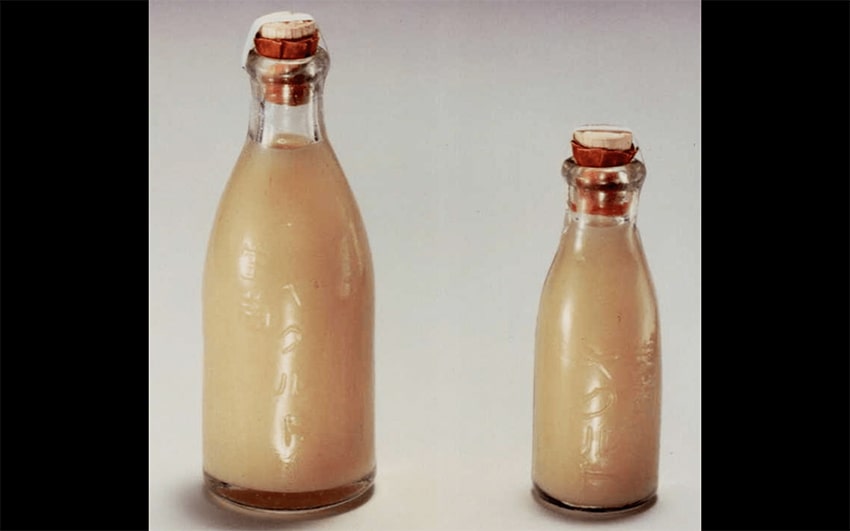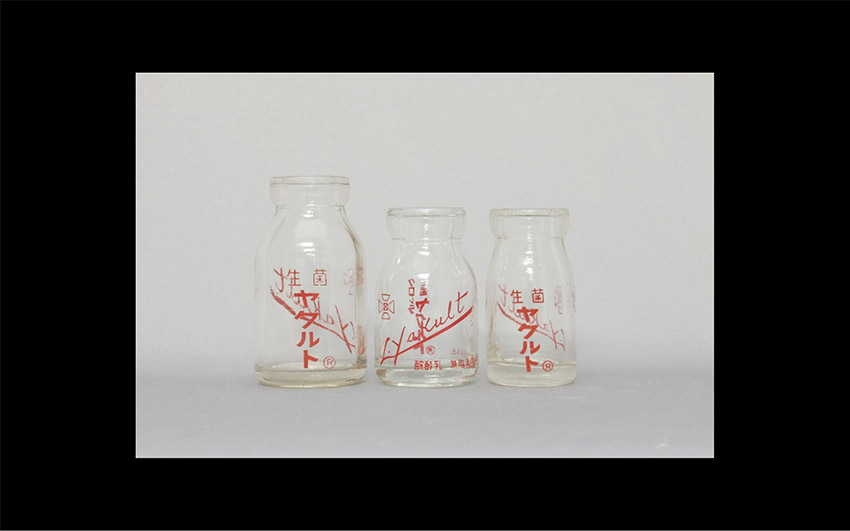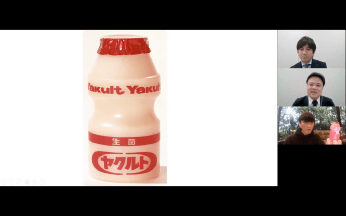

NF PR
The Secret of Yakult 1000
You are still,
I don't know Yakult
ICHIRO YAMAGUCHI interviews online
- Sponsored by Yakult Honsha -
Once ICHIRO gets curious, he can't stop, so he speaks to the developers and public relations staff about the inside story behind the development of "Yakult1000" and the corporate culture of Yakult, the company that created it.


Top left: Osamu Watanabe, Development Department Top right: Hideki Maruyama, Public Relations Department
Osamu Watanabe (hereafter referred to as W) of the Development Department:"I appreciate you saying that. Before this product was released, our company had a product called 'Yakult 400', which was released in 1999 and had the highest number of bacteria. Since then, we have continued to develop it to have an even higher number of bacteria, and we finally managed to launch 'Yakult 1000' in October 2019. So, it took Yakult 1000 about 20 years of research and development to reach the market, and it is the culmination of that."
Y: "It took 20 years for Yakult 1000 to be released after Yakult 400?"
W: "There are two reasons why it took so long. The first is that it is very difficult to increase and maintain the number of bacteria in a product. The second is that we already have Yakult 400, and we had to provide a different value to customers from Yakult 400. We needed to be able to explain that value scientifically before we launched it. In order to promote the effects and functions of a food, rather than a drug, we need to provide proper evidence and obtain government permission or submit a notification as a specific health food or functional food. For Yakult 1000, we conducted clinical trials (click here for details on the clinical trial data) to demonstrate that it "has the function of relieving stress in situations where temporary mental stress is present and improving sleep quality (depth of sleep, refreshing awakening)," and after obtaining the data, we submitted a notification as a functional food. These are also reasons why it took so long."
Y: First of all, what is Shirota strain? Is it a lactic acid bacterium? I've heard the word lactic acid bacteria since I was a child, and I have the image that it improves stomach conditions, etc.
W: Yes, it is lactic acid bacteria. Yakult was created by a medical doctor named Minoru Shirota. He aspired to develop preventive medicine to prevent illness in the 1920s, when Japan's sanitary environment was still poor and many children died from infectious diseases. He believed that intestinal health could lead to longevity and disease prevention, and discovered that lactic acid bacteria suppress harmful bacteria in the intestines. There are genera and species of lactic acid bacteria, and even the same type of lactic acid bacteria has completely different characteristics depending on the strain. Bacteria that produce lactic acid fall into the category of lactic acid bacteria, but even if you ingest lactic acid bacteria, there is a barrier of digestive fluids such as gastric juice and bile, which have strong bactericidal properties, so many of them die before reaching the intestines. Lactobacillus casei Shirota strain is a bacteria that has been strengthened and cultured to reach the intestines alive, and it can be said to be a carefully selected bacteria.
Y: "There are many different types of lactic acid bacteria in the category of lactobacillus, but you discovered that this was the lactobacillus that could overcome stomach acid and reach the intestines! So you were saying in the 1920s that a healthy intestinal environment was important for good health?"
W: Yes, that's right. Our company has a philosophy that is the basis of our business, called "Shirotaism." It is the idea of "preventive medicine," "a healthy intestine leads to a long life," and "affordable prices for everyone." Shirota has been advocating these ideas since the 1930s, when the business began. In recent years, the importance of preventive medicine and the fact that intestinal bacteria are related to health in various ways have been scientifically proven.
Y: "In the 1920s, even if Shirota had said, 'You should improve your intestinal environment for your health!', ordinary people would have been like, 'What are you talking about?' (laughs)."
W: "That may have been the reaction (laughs). But the company Yakult was started when people who agreed with Shirota's vision formed a team to sell Yakult. I think the Yakult business was started because there were people who sympathized with Shirota's vision even back then."
Y: "That's amazing, isn't it? Mr. Shirota and those around him may have had the conviction that the intestinal environment is important, but spreading that knowledge to the world through the product Yakult is something you can't do without self-confidence. Most people at the time weren't even aware of the intestinal environment. It's amazing that they've managed to grow it into such a big company. Mr. Shirota is kind of like an alien (laughs)."
Public Relations Office, Hideki Maruyama (hereafter: M):"However, our business did not grow smoothly from the beginning. As I mentioned earlier, general consumers had a poor understanding of lactic acid bacteria, and many people had a negative image of bacteria when they heard about them. So we carefully explained to our customers that there are bacteria that are beneficial for the body."
Y: "I see. Nowadays, we think of lactic acid bacteria as being good for the body, but back then, if you heard the word "bacteria," you might have thought of germs."
M: "We started by asking, are bacteria really good for the body? We explain what lactic acid bacteria are, and we make it a priority to make sure that our customers are convinced when they drink our products. We also sell our products overseas, but because bacteria are often referred to as bacteria overseas, some people have a negative impression of our products. We have popularized our products by dispelling such impressions."

W: "It's not impossible if you pick up bacteria from a product and cultivate it. However, as I said before, it's difficult to increase and maintain the number of bacteria. For example, in the case of "Yakult1000," we guarantee that there will be 100 billion live bacteria in the product until the expiration date. The cultivation techniques and selection of ingredients for this are the result of know-how gained from making "Yakult" for over 80 years, so even if you just pick up the bacteria, it's not easy to make a product with the same specifications."
Y: I see. It seems like it's difficult to keep 100 billion bacteria in this product, but what is so difficult about it?
W"First of all, culturing the bacteria is difficult. The way the bacteria grow varies depending on the raw materials used. Also, to increase the number and density of bacteria, it is necessary not only to increase the bacteria, but also to stabilize the number of bacteria. Lactic acid bacteria produce lactic acid, which has a strong sour taste, so if too much lactic acid is produced, the product becomes sour and becomes unpalatable. Bacteria are generally weak against acid, so if too much acid is produced in the product, it affects the flavor and the bacteria themselves become weak and cannot survive for long. We try to avoid producing too much lactic acid in the product as much as possible, so we devise various methods, such as selecting raw materials and culturing methods, and make improvements while making our products. It really is packed with a lot of know-how."
Y: "I see. When we make music, there is music that we want a lot of people to listen to, and music that we want to make ourselves. We're music freaks, so we listen to a lot of music from all over the world and we like difficult music, but we also have to make music that people who aren't that interested in music will also like. From what you've said, it's not just about putting in a lot of Shirota strain, but also making it taste good, otherwise a lot of people won't drink it, so it's difficult to strike that balance. To do that, you need a variety of techniques."
W: "That's right. After all, it's a food product, so we need to make sure that people enjoy it and continue to drink it. That's something the development department places great importance on."

M: "This container was introduced in 1968, and I'd like to explain the history of the container with photos. The first photo (Photo 1) is a group photo of the Daita Protective Bacteria Laboratory in Fukuoka, where Yakult was first manufactured and sold in 1935. You can see the Yakult from that time in this photo, but Yamaguchi-san, do you know where it is?"

M: "That's right. This was Yakult at the time, in a 720mL bottle. At first, it was sold to customers to dilute before drinking, but over the years, it gradually changed to a type that could be drunk as is. The second photo (Photo 2) shows Yakult that could be drunk as is, but at the time, the shape and volume of the bottles varied depending on the region. The people who sold Yakult in each region sold it in the bottles they chose themselves."

M: Yes, that's right. However, with the desire to have more people drink Yakult, it would not be good to have different containers depending on the region, so in 1955 Yakult Honsha Co., Ltd. was established. At that time, the containers were standardized, as shown in the third photo (Photo 3). This was released in 1955 and was sold in 65mL, 45mL, and 30mL containers. However, glass bottles containing Yakult are very heavy. At the time, sales were increasing and the number of Yakult Ladies who deliver Yakult to homes and other places was gradually increasing, but at the same time, reducing the workload of Yakult Ladies became an important issue. Also, like milk bottles, collected containers were washed and recycled, so the need for new containers from a hygienic standpoint was discussed. Then, in 1968, the container shown in the fourth photo (Photo 4), designed by Isamu Kenmochi, was introduced.



M: "The size is a little different, but the shape is the same as it was in 1968. We currently sell nine types of Yakult, including Yakult 1000, Yakult 400, and New Yakult."
Y: "When did Yakult Ladies first appear?"
M: "In 1963. We had been delivering Yakult before, but in 1963 we started to employ women to deliver products in an organized way, which we called the Ladies Sales System."
Y: That's also a good strategy for the company.
M: "This is still the case today, but most Yakult Ladies are housewives. At the time, many of the customers we delivered to were housewives who were looking after their families, so we thought that the people we could communicate with on an equal footing would be housewives in the same position. That's how Yakult Ladies were born."
Y: "Listening to your story, you must have had some incredible brains (laughs). By the way, who came up with the name "Yakult"? There is a "YAKULT" logo in the photo from 1935 (Photo 1)."
M: There are various theories about the name, but it seems that in the universal language of Esperanto, yogurt is called "Yafuruto," and because it is difficult to say "Yafuruto," the word was coined to mean "Yakult."
Y: "I have studied Esperanto myself, and in the 1920s there was a lot of activity to make Esperanto a global language. That means Yakult was aiming to become a global company even back then."
M: Yes. Health is a universal wish, so I heard they used Esperanto.
Y: "It's amazing that in the 1920s they were convinced that lactic acid bacteria were good for the intestines and not only did they spread it throughout Japan, but they also used Esperanto when deciding on the company name to make it global. Their corporate strategy is also amazing, as they had Isamu Kenmochi design the bottle. I'd love to visit Yakult's headquarters next."
W"The Central Research Institute in Kunitachi, Tokyo, is also home to the Shirota Memorial Museum, which displays the history of Yakult, so please come and visit. Due to the effects of COVID-19, we are currently unable to accept visitors, but we will be happy to accommodate you once the situation changes."
Y: "Please let me visit your research lab. I'm very interested in you. Thank you very much for today."
W, M: Thank you very much.
Notification: This product contains Lactobacillus casei strain Shirota (L. casei YIT 9029), which has the function of relieving stress in situations where temporary mental stress is present, and improving sleep quality (depth of sleep, refreshing awakening). In addition, Lactobacillus casei strain Shirota (L. casei YIT 9029) has been reported to have the function of improving the intestinal environment.
・This product is a functional food. Unlike foods for specified health uses, it has not been individually inspected by the Commissioner of the Consumer Affairs Agency.
-This product is not intended for the diagnosis, treatment, or prevention of disease.
・From mobile phones and PHS, call Navi Dial 0570-00-8960 (charges apply)
・(Reception hours: 9:00-17:00, excluding Saturdays, Sundays, public holidays, summer holidays, New Year's holidays, etc.) *Hours may be shortened.
https://www.yakult.co.jp/yakult1000/
